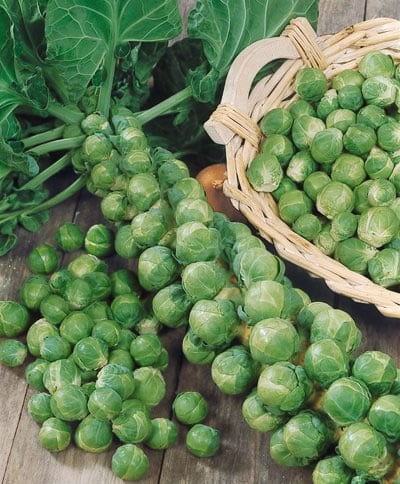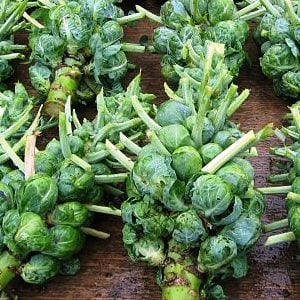
Learning Download: How to Grow Brussels Sprouts
From Seed to Harvest: A beginner’s guide to growing Brussels sprouts.
A beginning species of Brussels sprouts actually originated in Ancient Rome, and small, cabbage-like vegetable was brought to America in the 1800s. Brussels sprouts belong to the Cole Crop family and grow throughout a long season with a fall harvest. They can be prepared in various ways, such as roasting, boiling or eaten in thin shavings.
To plant:
Brussels sprouts seeds are planted in the spring for a fall harvest, but they must be started indoors four weeks before the last frost date. When you transplant the sprouts to your garden, plant them two feet apart in rows set three feet apart.
To grow:
Brussels sprouts don’t mind water on their leaves, and gardeners can water the plant freely. If lower leaves begin to yellow, remove them from the plant. As sprouts begin to grow on the plant, sometimes the plant can becomes top heavy so it is suggested to stake the plant or hill soil around it if you experience this problem. A tip to increase the quality of the sprouts is topping the plant about three weeks before the harvest. To top the plant, cut the tip of the plant off above the Brussels sprouts when the sprouts are still young. This redirects extra energy to the sprouts’ growth.
To harvest:
For the best sprouts flavor, wait until after the first fall frost to harvest, as the frost provides a sweetness to the sprouts. Sprouts are ready when their buds are green and about one to two inches in diameter. If you are not harvesting the whole stalk, twist the sprouts off the stem and harvest from the bottom up, as this is how Brussels sprouts mature. Only pick as many as you need, and the sprouts can stay on the stem through the first part of winter. The smaller, tender leaves of the plant also can be harvested and cooked like collards.
What Brussels sprouts craves:
Brussels sprouts crave a well-nourished soil with a pH of 6.8 and plenty of water, such as an inch a week. Brussels sprouts are treated like broccoli and cauliflower and don’t require lots of additional nitrogen to grow, but do best in well-drained soil. Sprouts require six hours minimum of sunlight daily.
Where to buy Brussels sprout seeds:
You can find a handful of different Brussels sprout seed varieties at Urban Farmer.
Learning Download: Common pests and diseases: Brussels sprouts
Common pests and diseases: Brussels sprouts
When growing vegetables, it is always exciting to care for the plant throughout its growing phase and then harvest it for delicious recipes later on, but one thing to watch for is pests and diseases. Different plants are susceptible to different types of pests and diseases, and it is important to make yourself aware so you can keep a watchful eye and also take any preventative methods to keep your plants safe throughout their lifespan.
Brussels sprouts can fall victim to several different pests and diseases.
Pests:
Like broccoli and cabbage, Brussels sprouts are a member of the Cole family and they are often affected by the same type of pests. The most common pests affecting Brussels sprouts are aphids, cutworms and many others.
Aphids are tiny insects with soft bodies, and they feed on the leaves’ undersides. This will cause the leaves to wrinkle or become discolored. Spray the insects with water from the hose and that will knock them off. Use insecticidal soap or neem oil to treat the infestations.
Cutworms are another popular pest affecting Brussels sprouts, and they usually feed at night. To prevent this, you can plant seedlings instead of seeds and wrap collars around the stems to protect them.
T prevent most insects from hurting your young Brussels sprouts plants, utilize row covers and be sure to rotate your crops each year and don’t plant Cole family crops in the same space more than every three years, because certain pests can live in the soil and feed off the roots of these types of plants.

Leaf miners are another pest affecting Brussels sprouts. These are flies, but it is the larvae that cause the issues to the plants and not the flies themselves. The easiest way to identify if leaf miners are affecting your plants is by the damage they cause, which looks like yellow squiggly lines on the leaves. This is proof that the leaf miner has bored its way into the plants. The best treatment method is using pesticides.
Diseases:
Similar to broccoli, the most common types of diseases affecting Brussels sprouts are bacterial and fungal diseases. To minimize bacterial diseases, keep away from overhead watering, and once you see a pant is affected, remove it from the garden. This can also help prevent fungal diseases as well, because they thrive in moist conditions, similar to bacterial diseases. To help prevent fungal diseases, make sure you remove all dead plant debris from the garden before the winter because some of these diseases can overwinter in the debris.
Certain molds also affect Brussels sprouts plants, like downy and powdery mildew. To prevent these, utilize drip irrigation and make sure you space out your plants enough to provide good air circulation.

